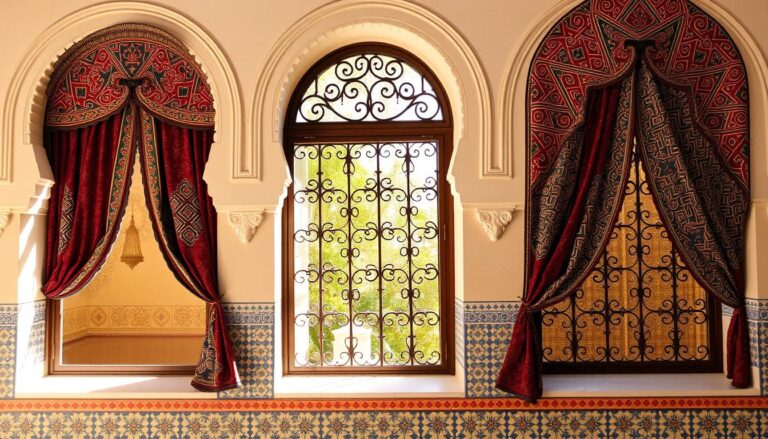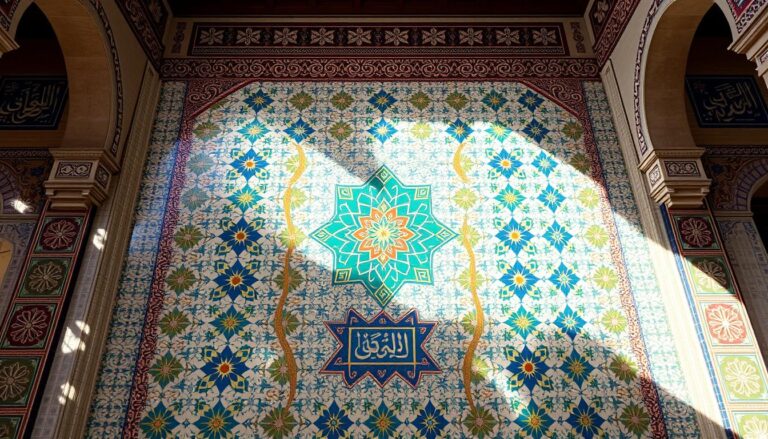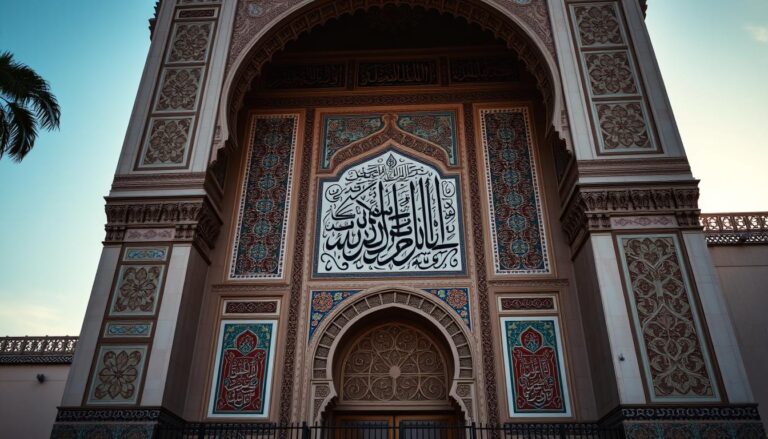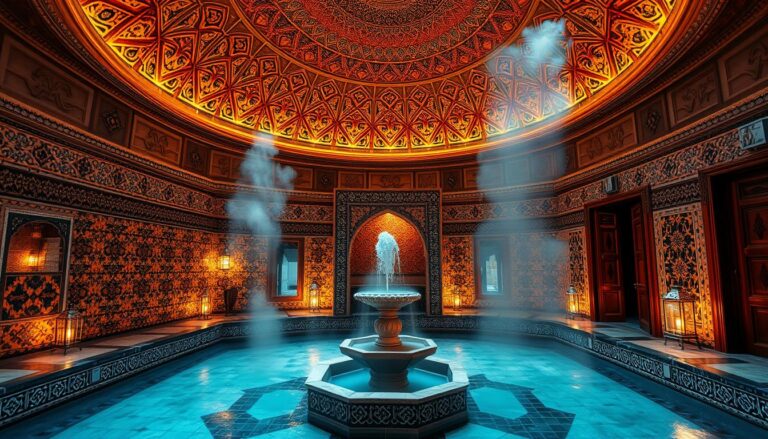Can traditional Moroccan design and modern sustainability go hand in hand? The answer is yes, as seen in Morocco’s eco-friendly buildings. These structures are changing Morocco’s landscape, setting new standards for green development.
Key Takeaways
- Morocco is leading the way in eco-friendly architecture, with innovative green buildings that care for the environment.
- In Marrakech, Rabat, and other cities, sustainable structures are setting high standards for green development.
- Les Jardin Des Medina and Dar Infaiane in Marrakech have earned top sustainable certifications for their eco-friendly designs.
- Riad Fes and Riad Laaroussa in Fes blend traditional Moroccan architecture with modern sustainable features.
- Moroccan builders use passive solar design and natural ventilation to save energy and cut cooling needs.
Sustainable Moroccan architecture
In Marrakech’s heart, two eco-friendly spots are setting a green example. Les Jardin Des Medina and Dar Infaiane have the Green Key Label. They show their dedication to green design and practices.
Les Jardin Des Medina: A Charming Eco-Oasis in Marrakech
Les Jardin Des Medina stands out in sustainable Moroccan architecture. It offers breathtaking rooftop views and a tranquil garden with old olive trees and exotic plants. This eco-friendly spot has won an award of excellence for its green efforts.
Dar Infaiane: Embracing Local Materials and Traditions
Dar Infaiane is another eco-friendly gem in Marrakech. It blends sustainable designs with traditional Moroccan architecture. With the Green Key Label, it offers a peaceful stay and supports the local community by using local food and helping community projects.
“Salima Naji, a famous Moroccan architect, stresses the need for renewable and recyclable materials in building. Her designs focus on natural cooling, energy efficiency, and involve local workers. This boosts job creation and supports local businesses.”
Traditional Wisdom Meets Modern Sustainability
In Morocco, the old art of making mud bricks is still alive. It’s a green way to build homes today. These bricks are made from clay, sand, and sometimes plants. They show Morocco’s love for building green and saving energy.
The Magic of Mud Bricks
Mud bricks are better for the planet than concrete. They’re made by sun-drying, which is kinder to the earth. They keep homes cool in the day and warm at night, cutting down on heating and cooling needs.
“The use of mud bricks in Moroccan architecture is a testament to the region’s commitment to sustainability. These natural materials not only reduce the environmental impact of construction but also provide a level of thermal regulation that modern materials struggle to match.”
Mud bricks are good for more than just keeping homes cool. They use less energy to make than concrete and steel, and they can break down naturally. This green building style is a big part of Moroccan design. It’s making architects and builders think differently about how to build.
Moroccan buildings also use timber, a green material. Timber comes from trees that can grow back, making it a low-carbon choice for building. Using natural materials and smart design makes Moroccan buildings stand out. They’re known for being beautiful and good for the planet.
The world is facing big challenges like climate change and running out of resources. Moroccan building ways are a great example of how to build in harmony with nature. By using mud bricks and other green materials, Moroccan architects are showing us how to build better for the future.
Passive Cooling Techniques: Nature’s Air Conditioning
In Morocco, architects use nature to keep homes cool without air conditioning. These passive cooling techniques are good for the planet and follow local building traditions.
Moroccan homes have thick walls made from mud bricks and zellige tiles. These materials keep the inside cool in summer and warm in winter. The riad design, with its central courtyard and water, adds to the cooling effect, making homes feel like an oasis.
Windcatchers are also used to bring cool air inside. These structures, called Windtowers or Malqaf, catch the breeze and direct it into homes. This natural method cools spaces without using much energy.
“Passive cooling techniques can reduce cooling energy use by up to 50% compared to homes that solely depend on air conditioning.”
Moroccan architects use these passive cooling methods to make homes comfortable and energy-efficient. This approach is good for the environment and keeps Moroccan design traditions alive.
Green Oases: Remarkable Eco-Friendly Accommodations
In Morocco, eco-friendly hotels are popping up everywhere. They mix traditional Moroccan style with green ideas. This gives visitors a chance to see Morocco’s culture and care for the planet at the same time.
The Atlas Kasbah Ecolodge in Agadir is a standout. It’s the first eco lodge in North Africa and Morocco. It uses clean energy, recycles water, and works with local groups. The Mazagan Beach Spa and Golf Resort also gets high marks for its green efforts.
The Terres D’Amanar works with local groups to cut down on waste. The Ouirgane Ecolodge in the Ouirgane and Toubkal National Park uses smart water and energy systems. This helps keep the area’s nature in balance.
“These eco-friendly accommodations not only provide a luxurious and comfortable stay, but they also serve as shining examples of how traditional Moroccan hospitality can be seamlessly integrated with modern sustainability practices.”
Places like L’ile de Ouarzazate and Riad Toubkal in the Atlas Mountains are leading the way. They show Morocco’s dedication to being green and helping the community. These spots let visitors enjoy Morocco’s culture and help the planet at the same time.
As more people want to travel green, Morocco’s eco hotels will shine even brighter. They inspire travelers to explore Morocco’s beauty without harming the environment.
Conclusion
Moroccan architecture shows how old wisdom and new green ideas can meet. It makes buildings that are not only beautiful but also good for the planet. Morocco uses mud bricks and cool designs to keep buildings eco-friendly.
The country’s focus on sustainable Moroccan architecture teaches us a lot. It shows how to blend traditional Moroccan design with today’s green needs. This approach is seen in many green construction projects across Morocco.
By keeping its cultural roots alive, Morocco leads the way to a greener future. Its efforts to save earthen buildings and use sustainable materials inspire others. This shows that sustainable Moroccan architecture is a model for a better, more eco-friendly world.
Source Links
- Morocco Top Green Buildings
- The Timeless Design of Moroccan Homes
- Design a sustainable retreat in Morocco: Moroccan Oasis Retreat is launched!
- Architecture & Sustainability – MOBT Global
- A Pioneer Bio-Climatic Architecture based on traditional knowledge in Morocco – Salima Naji
- Tradition and Sustainability in Vernacular Architecture of Southeast Morocco
- Historical Perspectives on Sustainable Building
- Creating Sustainable Tropical Buildings Through Passive Design Strategies | Autodesk Forma
- Sustainable Conservation of Architectural Heritage to Reduce Environmental Impact: The Morocco Pavilion on Cartuja Island in Seville
- The Top 10 Eco Lodges in Morocco
- Sustainable Oasis: Eco-Friendly Resorts in the Sahara Desert | African Sahara
- Explore Morocco Morocco Green Key Properties
- Moroccan architecture
- The patio house in Morocco: A sustainable design strategy
- Microsoft Word – Session 7

The Editorial Team is a passionate group of Morocco enthusiasts dedicated to sharing the beauty, culture, and wonders of this captivating country. With diverse backgrounds and a deep love for travel, we strive to bring you engaging and informative content that inspires your Moroccan adventures. From uncovering hidden gems and sharing local insights to exploring mouthwatering cuisine and showcasing the vibrant lifestyle, our team is committed to providing you with valuable resources and exciting stories that enhance your exploration of Morocco. Join us on this journey as we celebrate the rich heritage and unforgettable experiences that make Morocco truly special.







